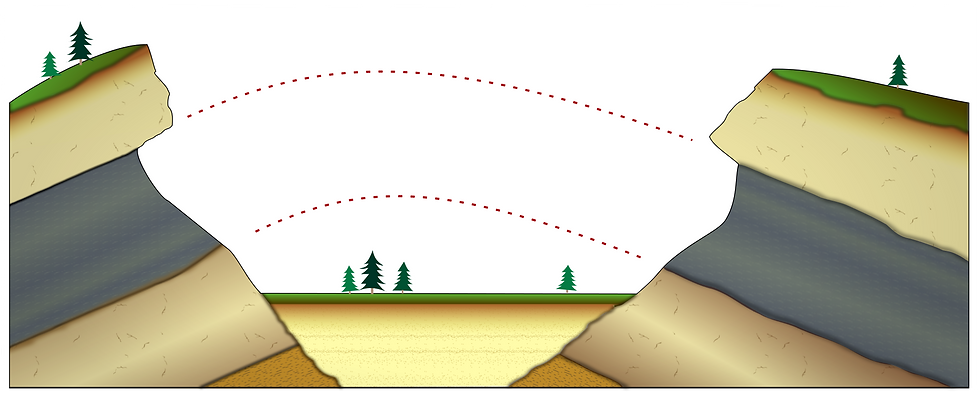Understanding Climate Change Through the Geological Record:
- jordanhealey5
- Jul 31, 2021
- 4 min read
A common phrase I was taught while studying geology is that “the present is the key to the past” - our understanding of the deep past is informed by what we observe today and the physical/chemical rules that explain why things are the way they are remain constant. This is formally recognised as the principle of “uniformitarianism”, which is the philosophical backbone to understanding the deep past and is especially true for understanding the climate. However, this logic can also be flipped, and we can use past geological events to better understand the uncertain future of the planet as it responds to current environmental change.

The geological record visualised in a useful graphic prepared by Ray Troll: https://www.trollart.com
One of the greatest social and political challenges we face today is climate change - the increase in average global temperatures resulting from anthropogenic CO2 emissions. Basic physics states that energy is conserved and that the balance between energy coming in and that being radiated away must remain steady for temperature to be stable. Throughout geological time three main parameters have controlled this balance where changes have led to global climates ranging from Snowball Earth to hyperthermal. These are:
1. The heat from the Sun reaching the planet - the Sun has brightened over time and this variable has steadily increased, although this takes place on timescales of millions of years. Astronomical variations in, for example, the tilt of the Earth or the geometry of the Earth’s orbit in the elliptical plane – called Milankovitch cycles – also control the amount of heat reaching the Earth on timescales of tens of thousands to hundreds of thousands of years.
2. The amount of energy that is reflected into space by clouds, particles in the atmosphere, ice sheets. This is the Earth’s albedo which is currently ~30%.
3. The concentration of greenhouse gases in the atmosphere, particularly the upper troposphere. This is most crucial towards understanding the current climate crisis as it has been rapidly increasing since records began.
Climate models, which use numerical methods to unravel the contributions of each of these variables, predict that a doubling of atmospheric CO2 will cause global temperatures to increase by 1-4.5°C. This is an extremely broad range of estimated variation and one of the major causes of this uncertainty is attributed to tipping points and feedback processes – resulting in non-linear feedback which is far more difficult to model than simpler linear systems. The impacts of climate change also vary significantly depending on regional effects such as wind/ocean currents and distribution of land vs. ocean, because land heats up much faster than the ocean.
An additional problem emerges due to the lack of observational data for climate and climate-related variable e.g. temperature, rainfall, atmospheric CO2 etc… The best continuous record of CO2, for example, only began recording data in 1958 while ice core data alone can provide 800,000 years of reliable data. The Zachos curve, one of the most famous graphs in the field of palaeoclimatology extends a temperature record back even further to ~66 million years ago (although at a lower resolution than the ice data) by applying techniques that analyse the ratio between oxygen isotopes O16 and O18 preserved in fossils known as foraminifera.
We have less than a century of observational data and so it becomes a valuable tool to look into geological archives such as ice-cores, tree rings and sedimentary rocks to give us a greater window of time to gain data from. To circumvent the uncertainties in models, we can also use clues from the past to better understand the processes that cause them to occur in the first place. This is where the field of palaeoclimatology is so valuable and underappreciated until recently – the 2013 IPCC report gives far greater attention to the field than previous reports and hopefully the next report, due later this year, will continue the trend.
By looking at past records we can say with confidence that the current amount of CO2 in the atmosphere is at the highest point seen in over 3 million years – long before humans evolved and during a time where giant sloths (up to 11 ft in length) roamed the Earth! This helps us put the current climate crisis into a broader context, and so we can begin to understand potential future impacts of climate change.
A recent study published by the Geological Society of London explores nine questions about climate change that we can better understand through our understanding of the geological record. These questions are as follows:
1. How has our climate changed in the past?
2. How does the geological record inform our quantification of climate sensitivity?
3. Is our current warming unusual?
4. How can the geological record be used to evaluate climate models?
5. When Earth’s temperature changed in the past, what were the impacts?
6. Are there past climate analogues for the future?
7. What does the geological record of climate change look like?
8. What does the geological record indicate about global v. regional change?
9. What is the role of geology in dealing with the climate emergency for a sustainable future?
It’s clear that palaeoclimatology contributes a great deal to our understanding of climate change and the better we understand the current crisis, the better we can come up with solutions moving forward. It's therefore greatly important that we continue to assess the archive that is the rock record (and others such as ice cores and tree rings) to better understand some of the largest sources of uncertainty regarding the current climate crisis.
Sources:


Comments